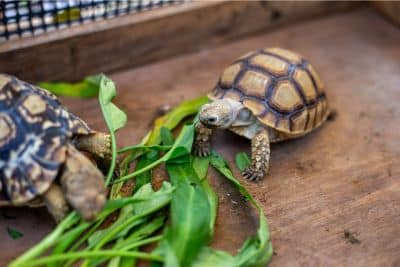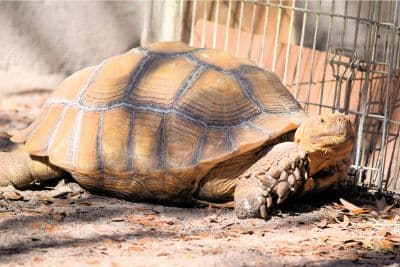As much as we love them, tortoises aren’t exactly brimming with energy. But that doesn’t mean a tortoise’s life should be boring! There are many activities and supplies you can use to enrich your tortoise’s day-to-day routine.
The right enrichment will expose your tortoise to new, interesting experiences and environments. It will also encourage your tortoise to explore its surroundings and help ensure it gets enough physical activity to stay fit and healthy.
This article is an introductory guide to tortoise enrichment activities and materials. You’ll also learn how to safely interact with your tortoise to create a fun and stress-free environment.
Types of Enrichment for Tortoises
Enrichment can take many forms. My favorite types of enrichment for pet tortoises include things like creating a more interesting physical environment and adding variety to meal times.
Physical Enrichment
It’s easy to make a tortoise enclosure more interesting by adding climbing structures, different substrates, hides, and more. Most of these materials can be bought at a pet store. You can also create some great tortoise habitats with a bit of DIY.
The average tortoise loves to climb. Rocks, logs, and ramps all make great climbing structures. Be sure that your tortoise can’t climb high enough to fall and/or escape its enclosure.
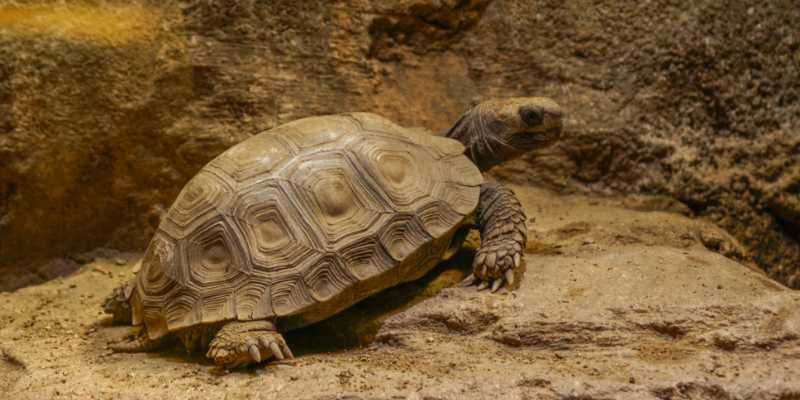
Fresh drinking water is a must in any habitat. But your tortoise might also enjoy a large bathing dish as well. Set this dish into the substrate so that it is flush with your tortoise’s walking surface. Choose a warm spot in the enclosure that isn’t directly under a basking lamp.
Many tortoises enjoy pushing things around with their snouts. If that sounds like your reptile companion, invest in a few “toys” it can move around its enclosure. These can include balls, pieces of wood, or even lightweight rocks. Since some tortoises will eat inedible materials like plastic, I recommend choosing items that are too hard and big to chew on.
Does your tortoise enjoy change? Consider collecting different enclosure accessories that you can mix and match whenever the old setup grows stale!
Dietary Enrichment
Meal time is probably the most exciting part of the day for your average pet tortoise. It’s also a great time to try out some enrichment strategies!
An easy way to start varying your tortoise’s routine is by introducing some new food types to their diet. These could include different types of produce, fruit, or weeds from your garden. I recommend offering these foods as small snacks in addition to your tortoise’s normal food. Note that fruit and some vegetables are high in sugar and should only be given sparingly.
Food puzzles are another excellent way to engage your tortoise’s brain during mealtime. Many pet stores sell balls and other gadgets that you can stuff with hay or leaves. The tortoise must work around the sides of the ball to access the food. You can also try making your own puzzle out of a small plastic tote.
A technique I like is to build a feeding routine around your tortoise’s natural foraging behaviors. In the wild, your tortoise’s meals aren’t served up on a silver platter. You can replicate natural foraging by hiding food around your tortoise’s habitat.
Here are a few more great ideas you can try:
- Hang grass or leaves just above your tortoise’s head so that it has to reach up (rather than down) to eat.
- Offer large pieces of produce that your tortoise has to work to break apart on its own.
- Add a few live, safe plants to the enclosure that your tortoise can graze from between meals.
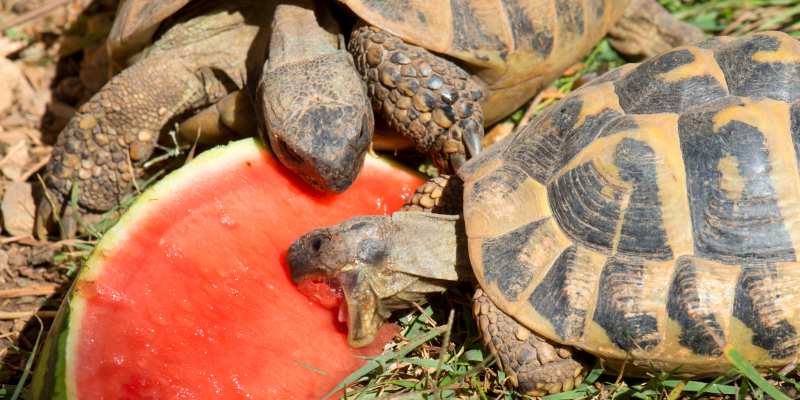
Sensory and Visual Stimulation
Speaking of live plants, I’m a huge fan of filling your tortoise habitat with non-toxic plants. If your tortoise lives indoors, place one or two potted plants in the enclosure — you can bury the pot in the substrate to prevent your tortoise from knocking it over. Outdoor habitats are easy to enrich with flowers, shrubs, and herbs both in and around the enclosure itself.
As an owner myself, I recommend adding visual obstacles and tortoise toys to the enclosure to boost enrichment. If your enclosure consists of a tortoise table or similar rectangular box, putting a large rock or fencing toward the middle of the habitat can make the environment more engaging. The idea is that your tortoise must physically roam around the enclosure to see it all, which encourages exercise and exploration.
If your tortoise has been in the same enclosure for a good bit of time, consider rearranging the space. I recommend starting small, as some tortoises may be stressed by a sudden change in the environment. If your tortoise seems keen on your redecorating efforts, you can make this a part of your monthly or semi-annual routine!
Of course, one of the best forms of sensory enrichment is providing your tortoise access to brand-new environments. These environments should be safe for tortoises (i.e., free of toxic plants, inedible materials, and dangerous obstacles). I highly recommend introducing an outdoor habitat to your tortoise’s routine if possible.
For example, one of my tortoise-owning friends maintains a smaller enclosure that their Russian tortoise gets to spend time in once or twice per week. While every tortoise has its own personality, their tortoise really enjoys this change of scenery!
Social Interaction
Most tortoises are loners. They don’t enjoy the company of fellow pets, people, or even other tortoises (except, of course, during mating season)!
There are a few species known for being more social than others. These include the Indian Star Tortoise, Radiated Tortoise, and Leopard Tortoise. Note, however, that male tortoises of these species may still show aggression toward each other. More social species may be housed together, given enough space.
I say all of this to set your expectations: a tortoise is not a pet that likes to play with others like a dog or cat might. But you can still introduce some social enrichment into your tortoise’s life if their personality allows!
One last note on introducing tortoises. Remember that tortoises — like any animal species — are susceptible to a range of illnesses. Diseases can easily spread from one tortoise to another. For everyone’s safety, you should only socialize healthy tortoises.
You may be able to introduce your tortoise to other pets in your home. Pets like small dogs, cats, and rabbits can all safely interact with a tortoise when supervised. I recommend against allowing your tortoise to hang out with large dogs — even the most well-trained dog can accidentally hurt a small tortoise.
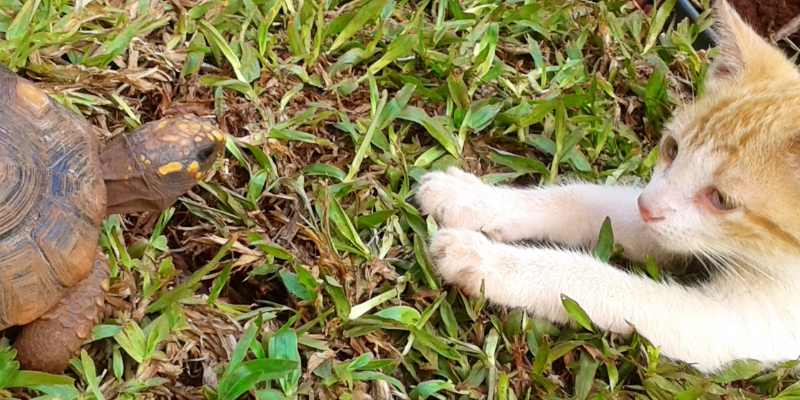
Before introducing your tortoise to another pet, make sure you have a safe, spacious area for the two to meet. If the space is too small, your tortoise may feel threatened. It’s also a good idea to include some hides, just in case the tortoise needs some extra privacy.
In most cases, I prefer human socialization to that of other animals. Despite what many people believe, tortoises can learn to recognize their owners and form positive bonds over time.
Food is a great motivator! Take advantage of feeding times to spend time near your tortoise and let it interact with you if it so chooses. According to the IIABC Foundation Journal, tortoises can even learn to perform “tricks”, but I can’t say I have personal experience with that.
As a rule, tortoises dislike being picked up or handled. However, I have met the odd tortoise who enjoyed a good shell scratching! Be sure to respect your pet’s space during these enrichment sessions and cut things short if your tortoise isn’t in the mood on any given day.
Maintaining a Safe Environment
All enrichment activities should happen at your tortoise’s own pace. Some tortoises have a greater tolerance for change than others. You should also take care to ensure every enrichment activity is safe for your tortoise. Common hazards to watch out for include toxic plants or food materials, climbing structures that are too high, or situations that cause extreme stress.
Forcing a tortoise to engage in enrichment activities can cause stress. I recommend taking a break and removing the enrichment materials if you notice any of the following signs:
- Lethargy
- Not moving around its enclosure
- Low appetite
- Hiding (in its enclosure or in its shell)
In some cases, stressed tortoises will actually be more active than their happy counterparts. If your tortoise appears to be agitated or is trying to escape or destroy its enclosure, this can also be an indicator of stress.
Adding enrichment materials to your tortoise’s enclosure can also eat up valuable space. This is part of why starting with a large enclosure is so important to long-term health and happiness. Don’t add enrichment materials that will limit your tortoise’s movement within its enclosure.
Are You Starving Your Tortoise?
Save 10% on premium tortoise food and supplements from Tortoise Resource Center on Amazon now using code BUYNOWGET10
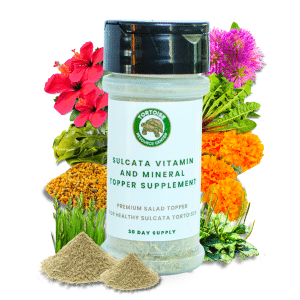
Sulcata Vitamin & Mineral Topper Supplement
30-Day Supply | 2 oz (56 g)
$24.99
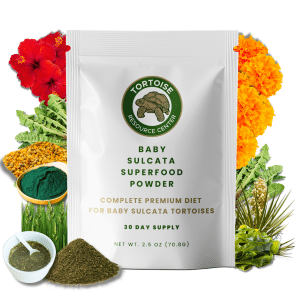
Baby Sulcata Tortoise Superfood Powder
30-Day Supply | 2.5 oz (70.8 g) Bag
$24.99
Citations
- IIABC Foundation Journal Tort Reform: On Training a Tortoise in Nose Work
- The Tortoise Trust Habitat Enrichment for Tortoises
- Tortoise Library Enrichment

